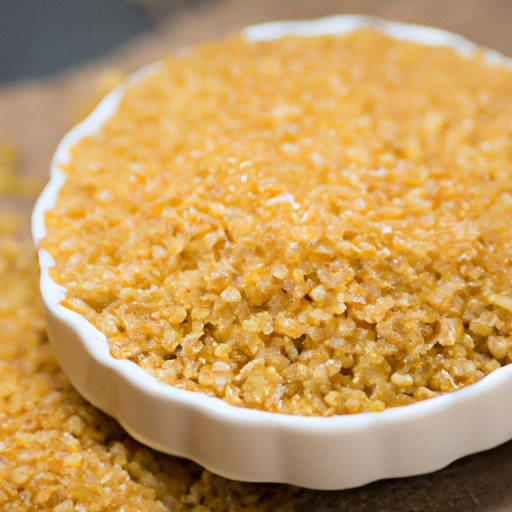Bulgur
Description

Bulgur is a whole grain made from cracked wheat, primarily from durum wheat but also other wheat species. It is pre-cooked or parboiled, dried, and then cracked, resulting in varying granulations from fine to coarse. Bulgur is a staple in Middle Eastern cuisine and is well-regarded for its nutty flavor, ease of preparation, and nutritional benefits. It is most commonly found in dishes like tabbouleh and kibbeh. Bulgur can be measured in both metric and customary units, with common measurements including cups, ounces (oz), grams (g), and pounds (lb) depending on the recipe and region.
Common uses
Bulgur is prominently used in Middle Eastern, Mediterranean, and some European and American cuisines. It is a versatile ingredient that can be used as a base for salads, a side dish to meats and vegetables, or a binding ingredient in meatballs and vegetarian patties. It can also be incorporated into soups, stews, and stuffings, or used as a healthier alternative to rice or couscous.
Nutritional value
Calories
A 1-cup serving (182g) of cooked bulgur contains approximately 151 calories.
Protein
That same serving size provides about 5.6 grams of protein.
Fat
Bulgur is low in fat, with a cup of cooked bulgur containing around 0.44 grams.
Carbohydrates
Carbohydrate content is about 34 grams per cup of cooked bulgur.
Vitamins
Bulgur is a good source of several B-vitamins, including niacin, B6, and folate.
Minerals
It is rich in minerals like magnesium, iron, and manganese.
Health benefits
Bulgur is high in fiber and has a low glycemic index, which can aid in digestion and help manage blood sugar levels. The grain's rich nutrient profile supports heart health, helps in weight management, and may reduce the risk of chronic diseases such as type 2 diabetes.
Potential risks
As bulgur is made from wheat, it contains gluten and is not suitable for those with celiac disease or gluten sensitivity. Overconsumption might lead to gastrointestinal discomfort due to its high fiber content.
Common recipes
Bulgur is a key ingredient in recipes such as tabbouleh salad, pilafs, kibbeh, and a variety of meatless burgers or patties.
Cooking methods
It can be boiled, soaked, or steamed, with the cooking method varying depending on the desired texture and the specific recipe.
Pairing with other ingredients
Bulgur pairs well with fresh herbs, vegetables, legumes, nuts, and lean proteins. It can be seasoned with an array of spices, from warm cumin to bright citrus flavors.
Summary
Bulgur is a nutritious, versatile whole grain with ancient origins and a firm place in modern kitchens across the globe. With its ease of cooking and health benefits, it's a great staple to incorporate into a variety of dishes, contributing both flavor and substance. Whether included in traditional Middle Eastern recipes or innovative global cuisine, bulgur is a hearty ingredient that satisfies.